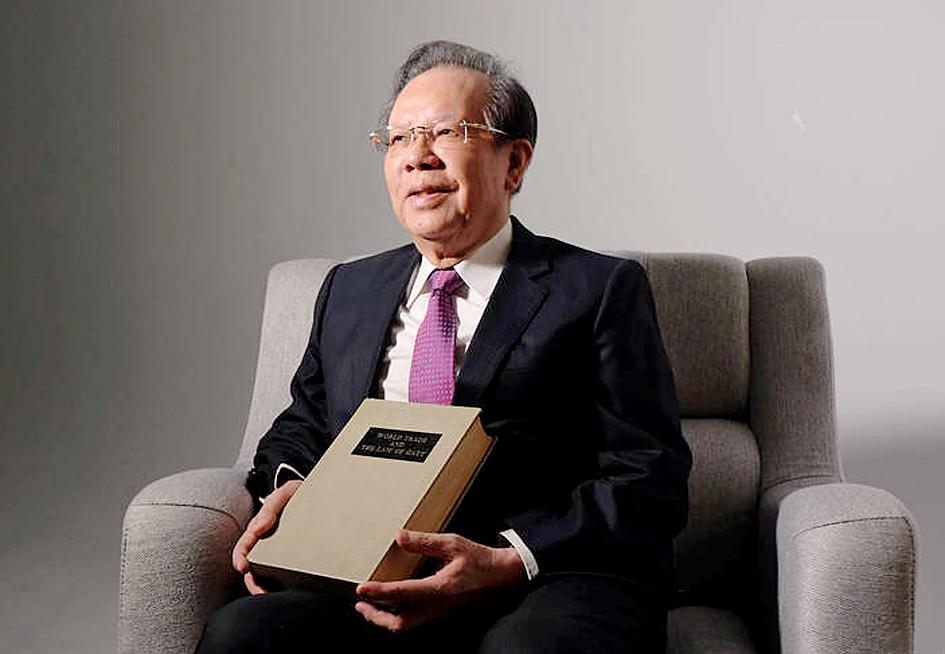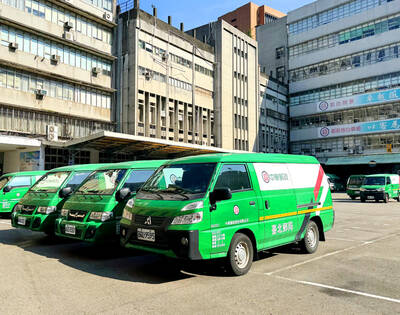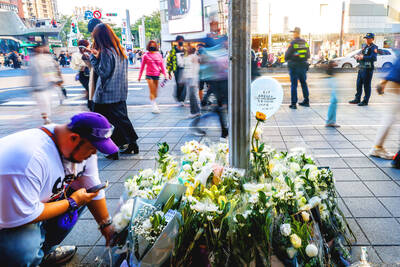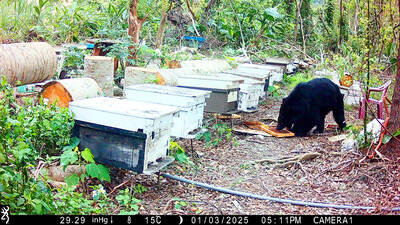Yen Ching-chang (顏慶章): The GATT [General Agreement on Tariffs and Trade, the predecessor to the WTO] was signed on Oct. 30, 1947. In its many drafts, it clearly stated that governments entering under the name “separate customs territory” essentially lack national sovereignty, so when Taiwan applied to enter the GATT on Jan. 1, 1990, it used the name “the Separate Customs Territory of Taiwan, Penghu, Kinmen and Matsu.”
Looked at another way, Taiwan had no way to compete with China due to international circumstances at the time, forcing the nation to minimize itself by applying not under its official title, but as a so-called “autonomous entity.”
This undeniably minimized our sovereignty, making us suffer within the global trade system ever since.

Photo: Hu Chih-kai, Taipei Times
This became most obvious in 1992, when a working group was formed to approve our application, followed by a series of bilateral trade negotiations. During a review meeting, the [GATT] chairman specifically mentioned that Taiwan’s representative throughout its time as an observer and then a full member should be “along the same lines” as that of Hong Kong and Macau. Not only that, but the titles used by Taiwan’s representatives could not have diplomatic connotations.
So this entire process essentially showed that, because of the name on our application, we do not have sovereignty and therefore all follow-up meetings and negotiations would continue to trample on our national dignity.
NEW WORLD AGREEMENTS
When we joined the WTO [in 2002], the attitude in Geneva [Switzerland] toward Taiwan was completely different than the global attitude today.
Because we had used the “separate customs territory” name, we were forced to call our delegations “economic and trade offices” in a similar convention to Hong Kong and Macau. All told, apart from the few small countries with which we had diplomatic relations, most nations tried to avoid the subject like the plague. The situation now is totally different.
When [former US] president Barack Obama was forming the TPP [Trans-Pacific Partnership], he repeatedly invited Taiwan to join, even going so far as to say that the point [of the trade bloc] was to counter China’s growing influence in the Indo-Pacific region.
Former Japanese prime minister Shinzo Abe also brought it up in his address to the US Congress, saying clearly that we must seek free and democratic economic cooperation in the Asia-Pacific, and in so doing, we must exclude members who bring intimidation. At the time, most people worldwide called the TPP the ‘anyone but China club.’
JOINING JAPAN’S CPTPP
As part of his “America First” policy, [former US] president Donald Trump withdrew from the TPP after his election, but maintained a strong presence in the region through trade and politics that deeply intimidated China.
Since the US withdrew, Abe led the 11 other members in completing the pact in 2018, making Japan leader of the new CPTPP. Then over the past few years, Japan has expressed strong support for Taiwan, although there are admittedly a few details that have upset Japan, such as the Fukushima food safety issue. [After the 2011 Fukushima Dai-ichi nuclear power plant disaster, Taiwan banned food from five Japanese prefectures.]
Truthfully speaking, Taiwan-Japan relations are very good in some areas. Since Taiwanese donated more money to Japan after the [2011] tsunami and power plant disaster than any other country, Japan is grateful and has shown its sincerity through policy.
This year happens to be Japan’s turn to lead the CPTPP, but its term will be over in less than two months. It is a shame because, if Taiwan had acted a little bit sooner, it could have worked with Japan. Instead we have wasted all that time from the establishment of the CPTPP in 2018 until now.
NAMES MATTER
Our application to join the CPTPP follows the naming convention from our 1990 GATT application. What is important to remember is that this “separate customs territory” name comes from the GATT charter. We cannot ignore that it is used for an unsovereign entity. If Taiwan is forced to resign itself to this title, there is nothing we can do.
As I said, in 1990 we applied under the “separate customs territory” name, then two years later in September and October 1992, the director-general accepted our application. In that meeting, the chairman further declared that the representative would be “hereinafter referred to as Chinese Taipei,” thereby also giving us that title in the GATT.
The way we translate it as Zhonghua Taibei (中華台北) sounds horrible, but it saves face. If it were translated directly from English would Taiwanese accept this name? This happened back in 1992; would Taiwanese today be willing to make such a concession?
POWERFUL FRIENDS
Today, Taiwan’s international situation has improved a lot. The US offers support in many areas, and it has only become more firm and apparent since [US President Joe] Biden took office.
We will of course not talk about countries that do not have a geopolitical relationship with the CPTPP, but among those that do, Japan is the biggest. There is also Australia, which has already stated that it wants to align with Japan and Canada. Canada has in the past not expressed a clear stance on Taiwan, but because of the Huawei [Technologies] situation, it has come to realize how China pressures its neighbors, including Canada.
So the CPTPP of course requires a consensus among its 11 members, the same as the WTO. In that consensus, we can imagine that if only one country opposes — no matter how big or small — Taiwan cannot join. However, we should also have confidence, since it also only takes one country to oppose China’s entry.
ALREADY ‘TAIWAN’
As for changing our name, I think it could be discussed in future negotiations.
Alternatively, another major member such as Japan could do what they did during the Tokyo Olympics and directly say “Taiwan” instead of “Chinese Taipei.” This is actually already happening internationally.
For instance, in all government documents and statements since breaking ties in 1979, the US has called us Taiwan; it has never used “Chinese Taipei.” It is the same with Australia — none of the countries with more economic weight in the CPTPP will call us the “Separate Customs Territory of Taiwan, Penghu, Kinmen and Matsu,” so we should not minimize ourselves, either.
I will not say it is impossible to change the name on our application. If it is possible, we could work with some big countries such as Japan, Canada and Australia to reach a consensus with the other members.
ONE CHOICE
Then of course there is only one choice of name. The Republic of China is definitely not feasible, because there are a lot of arenas where using this name is impossible.
Diplomacy is an extension of domestic affairs, but our domestic conversation around this issue is frankly confusing.
If we insist on using the Republic of China, it is too similar to the People’s Republic of China in English and therefore untenable internationally.
As we cannot accept “Taiwan, Penghu, Kinmen and Matsu,” the best middle ground is “Taiwan.”
However, there are still some Taiwanese who refuse to use this name, making it impossible to speak with any consistency at home, and adding a great deal of difficulty when trying to say what country you are from or which government you represent while abroad.
FIRST, CONSENSUS
I want to encourage all Taiwanese to think about this: Ever since we withdrew from the UN in 1971, we have been called the Republic of China, but now this term has no room for survival on the international stage.
How should we consider eliciting national pride with the consensus of all people? Most crucially, we must first have pride in this land before we can become great; we cannot wait to become great before we identify as a nation.
We must do this now, because if we do not change, over the next 50 years where will we find ourselves?
Reporting by Ou Hsiang-yi, Liu Yan-chen and Hu Chih-kai
Translated by Kayleigh Madjar

SHIPS, TRAINS AND AUTOMOBILES: The ministry has announced changes to varied transportation industries taking effect soon, with a number of effects for passengers Beginning next month, the post office is canceling signature upon delivery and written inquiry services for international registered small packets in accordance with the new policy of the Universal Postal Union, the Ministry of Transportation and Communications said yesterday. The new policy does not apply to packets that are to be delivered to China, the ministry said. Senders of international registered small packets would receive a NT$10 rebate on postage if the packets are sent from Jan. 1 to March 31, it added. The ministry said that three other policies are also scheduled to take effect next month. International cruise ship operators

HORROR STORIES: One victim recounted not realizing they had been stabbed and seeing people bleeding, while another recalled breaking down in tears after fleeing A man on Friday died after he tried to fight the knife-wielding suspect who went on a stabbing spree near two of Taipei’s busiest metro stations, Taipei Mayor Chiang Wan-an (蔣萬安) said. The 57-year-old man, identified by his family name, Yu (余), encountered the suspect at Exit M7 of Taipei Main Station and immediately tried to stop him, but was fatally wounded and later died, Chiang said, calling the incident “heartbreaking.” Yu’s family would receive at least NT$5 million (US$158,584) in compensation through the Taipei Rapid Transit Corp’s (TRTC) insurance coverage, he said after convening an emergency security response meeting yesterday morning. National

PLANNED: The suspect visited the crime scene before the killings, seeking information on how to access the roof, and had extensively researched a 2014 stabbing incident The suspect in a stabbing attack that killed three people and injured 11 in Taipei on Friday had planned the assault and set fires at other locations earlier in the day, law enforcement officials said yesterday. National Police Agency (NPA) Director-General Chang Jung-hsin (張榮興) said the suspect, a 27-year-old man named Chang Wen (張文), began the attacks at 3:40pm, first setting off smoke bombs on a road, damaging cars and motorbikes. Earlier, Chang Wen set fire to a rental room where he was staying on Gongyuan Road in Zhongzheng District (中正), Chang Jung-hsin said. The suspect later threw smoke grenades near two exits

The Forestry and Nature Conservation Agency yesterday launched a gift box to market honey “certified by a Formosan black bear” in appreciation of a beekeeper’s amicable interaction with a honey-thieving bear. Beekeeper Chih Ming-chen (池明鎮) in January inspected his bee farm in Hualien County’s Jhuosi Township (卓溪) and found that more than 20 beehives had been destroyed and many hives were eaten, with bear droppings and paw prints near the destroyed hives, the agency said. Chih returned to the farm to move the remaining beehives away that evening when he encountered a Formosan black bear only 20m away, the agency said. The bear